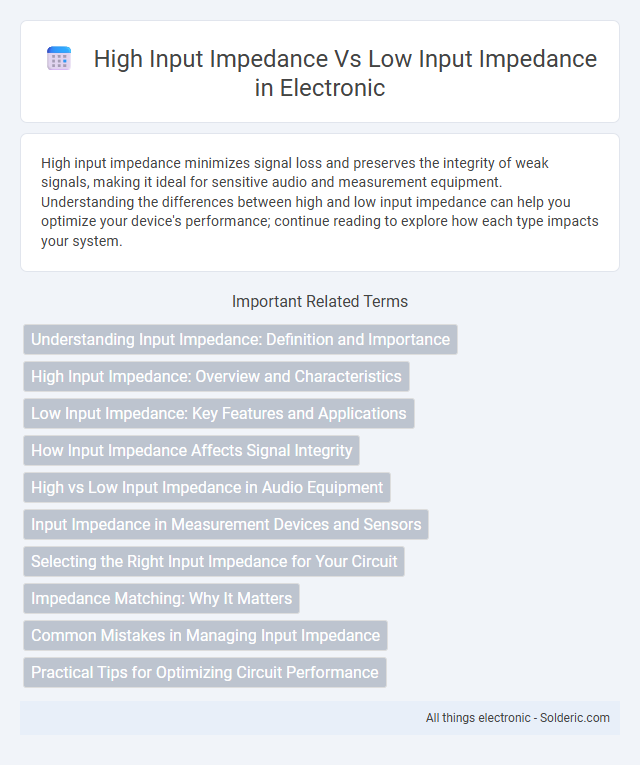High input impedance minimizes signal loss and preserves the integrity of weak signals, making it ideal for sensitive audio and measurement equipment. Understanding the differences between high and low input impedance can help you optimize your device's performance; continue reading to explore how each type impacts your system.
Comparison Table
| Feature | High Input Impedance | Low Input Impedance |
|---|---|---|
| Definition | Input impedance typically above 1 MO | Input impedance typically below 10 kO |
| Signal Loading | Minimal signal loading, preserves source signal integrity | Higher signal loading, can distort or attenuate input source |
| Applications | Used in amplifiers, sensors, and measurement devices | Used in output stages, power amplifiers, and controlled inputs |
| Noise Sensitivity | More susceptible to noise pickup | Less susceptible to external noise |
| Examples | FET input amplifiers, oscilloscope probes | BJT input stages, audio input mixers |
| Advantages | Preserves weak signals, avoids loading effects | Stable operation with low source impedance |
| Disadvantages | Can pick up interference, slower response times | May attenuate or distort signals from high impedance sources |
Understanding Input Impedance: Definition and Importance
Input impedance refers to the resistance a device presents to incoming signals at its input terminals, crucial for signal integrity and device compatibility. High input impedance allows minimal current draw from the source, preserving signal amplitude and reducing loading effects, making it ideal for sensitive measurement equipment. Low input impedance facilitates better noise rejection and is often used in power amplifiers or circuits requiring stable voltage references.
High Input Impedance: Overview and Characteristics
High input impedance refers to an electrical property of a device or circuit that resists the flow of incoming current, typically measured in megaohms (MO) or higher, which ensures minimal signal loss and prevents loading effects on the source. Devices such as operational amplifiers, voltage followers, and sensors often feature high input impedance to accurately measure or amplify weak signals without distortion. High input impedance circuits are essential in applications requiring signal integrity, such as audio equipment, instrumentation, and sensor interfaces.
Low Input Impedance: Key Features and Applications
Low input impedance typically ranges from a few ohms to a few kilo-ohms, enabling devices to draw significant current from the signal source. This characteristic is crucial in applications like power amplifiers and load-driving circuits, where strong signal buffering and current delivery are required. Low input impedance also minimizes noise susceptibility and improves signal stability in demanding electronic environments.
How Input Impedance Affects Signal Integrity
High input impedance minimizes the loading effect on the source, preserving the original signal amplitude and waveform, which is critical for maintaining signal integrity in sensitive measurements. Low input impedance can cause significant signal attenuation and distortion by drawing excessive current from the source, leading to inaccurate readings and degraded signal quality. Optimizing input impedance ensures accurate transmission of signal voltage levels, reducing noise susceptibility and measurement errors in electronic circuits.
High vs Low Input Impedance in Audio Equipment
High input impedance in audio equipment allows for minimal signal loss and preserves audio fidelity when connecting sources like electric guitars or microphones, preventing tone coloration. Low input impedance devices draw more current from the source, often resulting in reduced signal strength and potential tonal degradation, making them less ideal for passive pickups or high-impedance microphones. Matching input impedance with the source ensures optimal signal transfer and sound quality, particularly critical in professional audio setups and recording environments.
Input Impedance in Measurement Devices and Sensors
High input impedance in measurement devices and sensors ensures minimal signal load, preserving the original voltage and accuracy of the measurement. Low input impedance can cause signal distortion and measurement errors by drawing excessive current from the source. Choosing the right input impedance is crucial for maintaining the integrity of your sensor readings and achieving precise data acquisition.
Selecting the Right Input Impedance for Your Circuit
Choosing the right input impedance for your circuit depends on the source device and desired signal integrity. High input impedance circuits minimize loading effects and signal attenuation, making them ideal for sensors and high-impedance sources, while low input impedance circuits provide better noise immunity and stability in low-impedance environments. Matching input impedance with the source impedance ensures optimal voltage transfer and prevents distortion in analog and mixed-signal applications.
Impedance Matching: Why It Matters
High input impedance minimizes signal loss by drawing less current from the source, preserving signal integrity in audio and measurement systems. Low input impedance is essential for effective impedance matching in transmission lines to prevent signal reflections and maximize power transfer. Your choice between high and low input impedance directly impacts the performance and accuracy of electronic circuits, making impedance matching crucial for optimal functionality.
Common Mistakes in Managing Input Impedance
Common mistakes in managing input impedance often include mismatching the input impedance with the signal source, which can lead to signal loss or distortion. High input impedance is essential for preserving signal integrity when connecting to low-current sources, while low input impedance may overload or attenuate sensitive signals. Ensure your equipment's input impedance aligns with the source requirements to prevent noise and maintain optimal performance.
Practical Tips for Optimizing Circuit Performance
High input impedance minimizes signal loss and reduces loading effects, making it ideal for connecting high-impedance signal sources such as guitar pickups or sensor outputs. Low input impedance circuits are useful for ensuring stable operation and noise immunity in environments with strong interference or when interfacing with low-impedance sources like power amplifiers. To optimize circuit performance, select impedance levels that match source and load characteristics, use buffering stages to preserve signal integrity, and employ proper shielding and grounding techniques to minimize noise.
High input impedance vs Low input impedance Infographic

 solderic.com
solderic.com